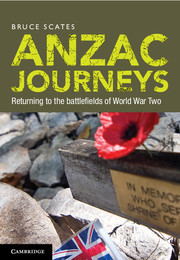Book contents
- Frontmatter
- Contents
- Maps
- Illustrations
- Acknowledgements
- Money, measurement and terminology
- Introduction
- PART 1 CAPTIVITY NARRATIVES
- 1 ‘If only I knew what has become of him’: The loss of Australia's prisoners of war
- 2 Witness to war: The first journeys
- 3 Bring up the bodies: Commemorating our war dead
- 4 Unspeakable histories: From Singapore to Hellfire Pass
- 5 The Death March: Journeys back to Sandakan
- PART 2 DESERT AND ISLAND
- PART 3 AIR AND SEA
- PART 4 AUSTRALIA'S FRONT LINE
- Conclusion
- Notes
- Index
5 - The Death March: Journeys back to Sandakan
from PART 1 - CAPTIVITY NARRATIVES
Published online by Cambridge University Press: 05 June 2013
- Frontmatter
- Contents
- Maps
- Illustrations
- Acknowledgements
- Money, measurement and terminology
- Introduction
- PART 1 CAPTIVITY NARRATIVES
- 1 ‘If only I knew what has become of him’: The loss of Australia's prisoners of war
- 2 Witness to war: The first journeys
- 3 Bring up the bodies: Commemorating our war dead
- 4 Unspeakable histories: From Singapore to Hellfire Pass
- 5 The Death March: Journeys back to Sandakan
- PART 2 DESERT AND ISLAND
- PART 3 AIR AND SEA
- PART 4 AUSTRALIA'S FRONT LINE
- Conclusion
- Notes
- Index
Summary
The Sandakan Death March began on the coast of northern Borneo and ended in its mountainous interior. In fact, there was more than one Death March, as the Japanese hurriedly concentrated their forces around Ranau. Japanese soldiers also suffered and died on the march. Resenting enforced relocation and fearing defeat, they subjected Allied prisoners to harsh and degrading punishment. Only six of more than 3000 British and Australian prisoners survived the ordeal on Borneo. For Australia this was surely the greatest tragedy of the war.
[You will feel] their presence in a rotted boot,
A blaze upon a tree that marks a grave,
A bullet scar still unhealed in the bark,
A scrap of webbing and an earth-stained badge,
A falling bamboo hut, a giant tree
They rested at this log, this creek,
This climb that r uns the sweat into your eyes –
Though you aren't laden, fevered, driven, starved
You tell yourself you know how they went by.
Colin Simpson, Six from BorneoCharlie, Jack and Larry's journey back along the railway was one of the last of its kind. As the veterans of World War II grow old they become less and less capable of so physically and emotionally taxing a journey. Soon there will be no survivors left to claim custodianship of this story – and that story will pass on to others.
- Type
- Chapter
- Information
- Anzac JourneysReturning to the Battlefields of World War Two, pp. 102 - 123Publisher: Cambridge University PressPrint publication year: 2013



